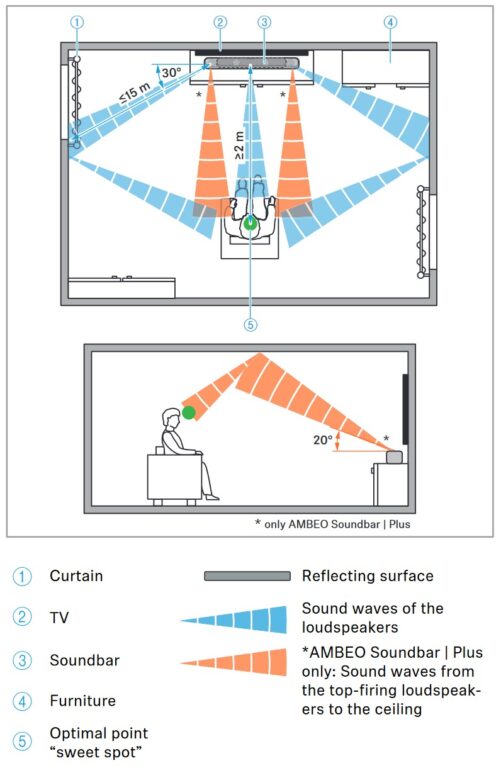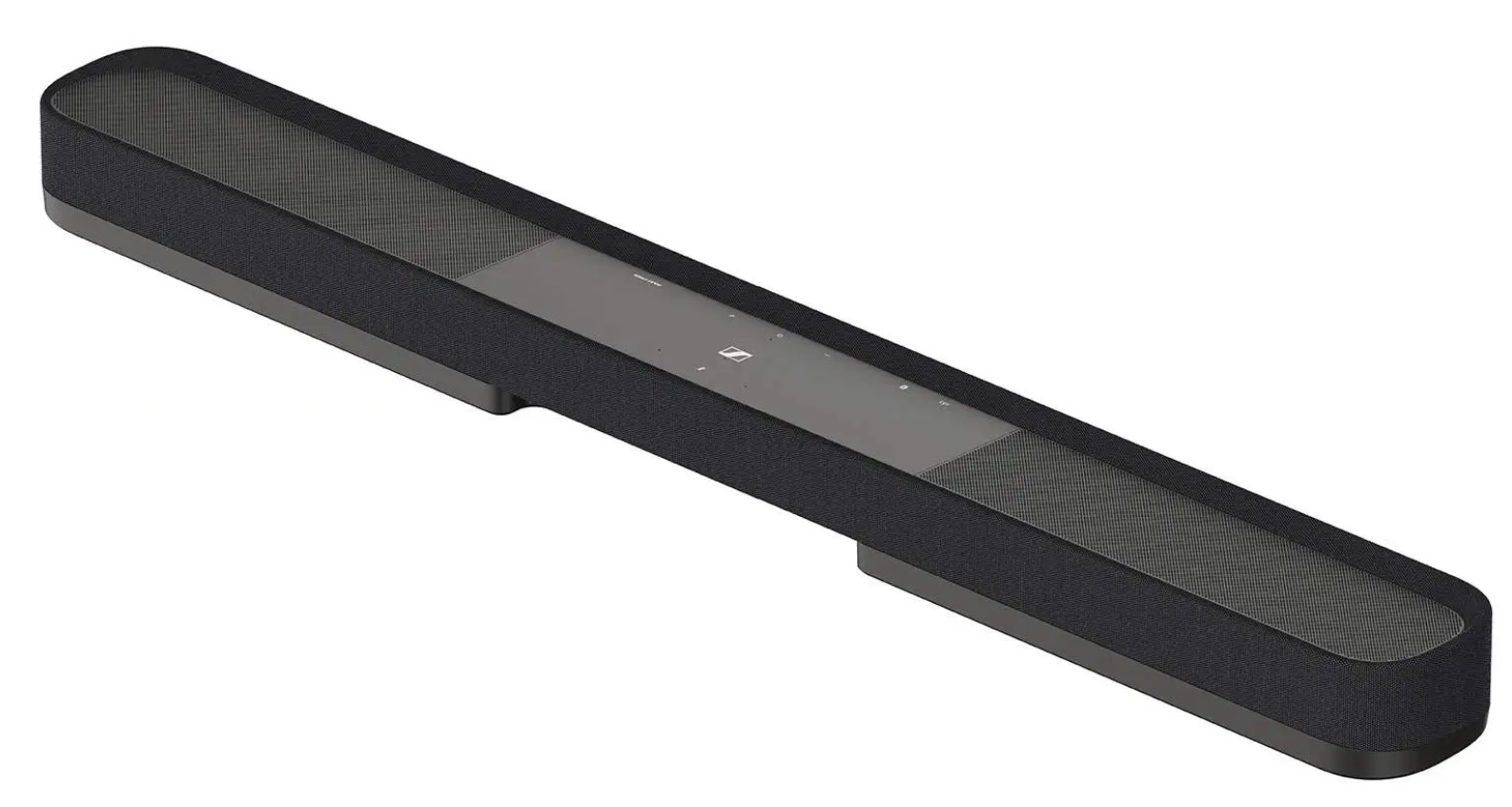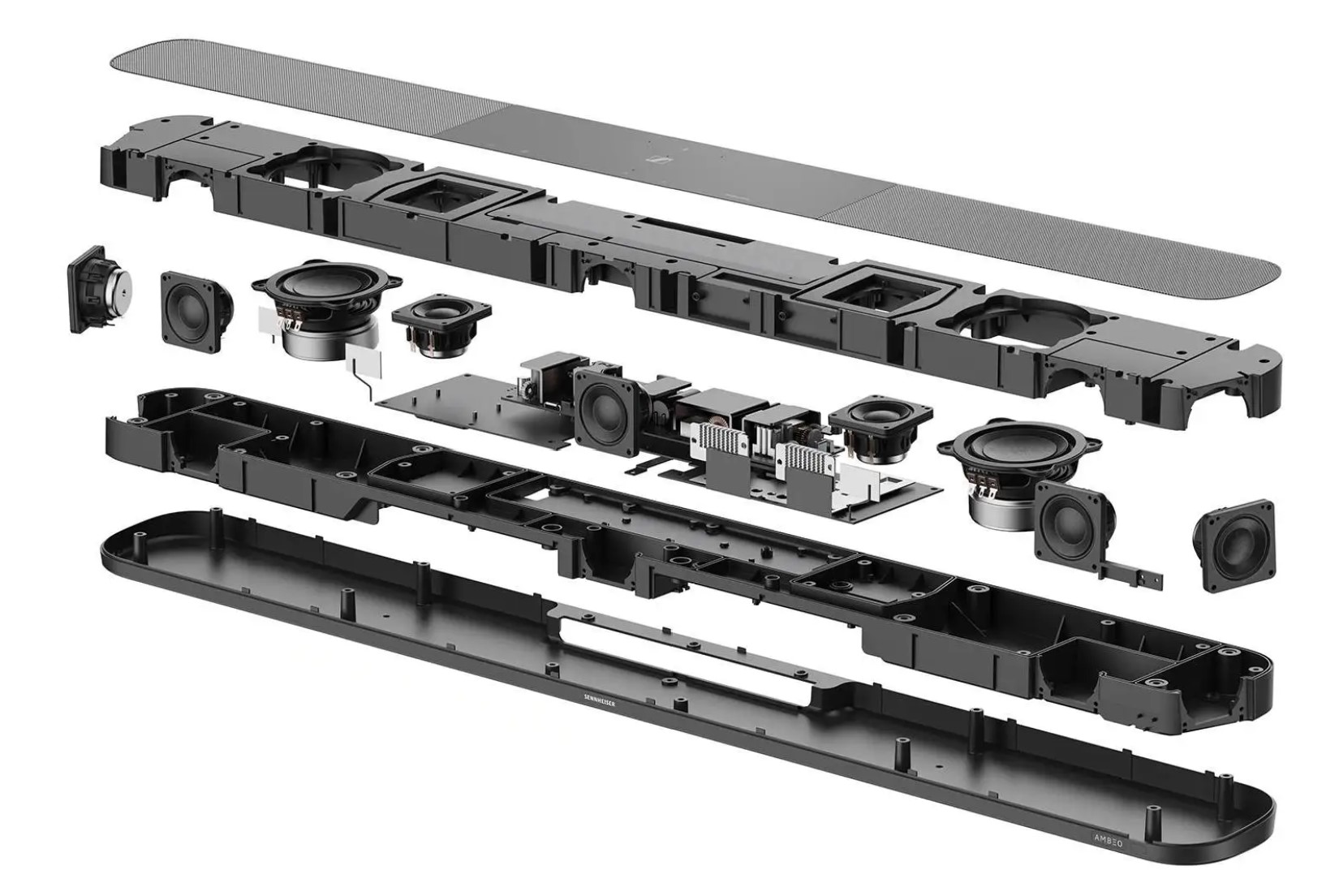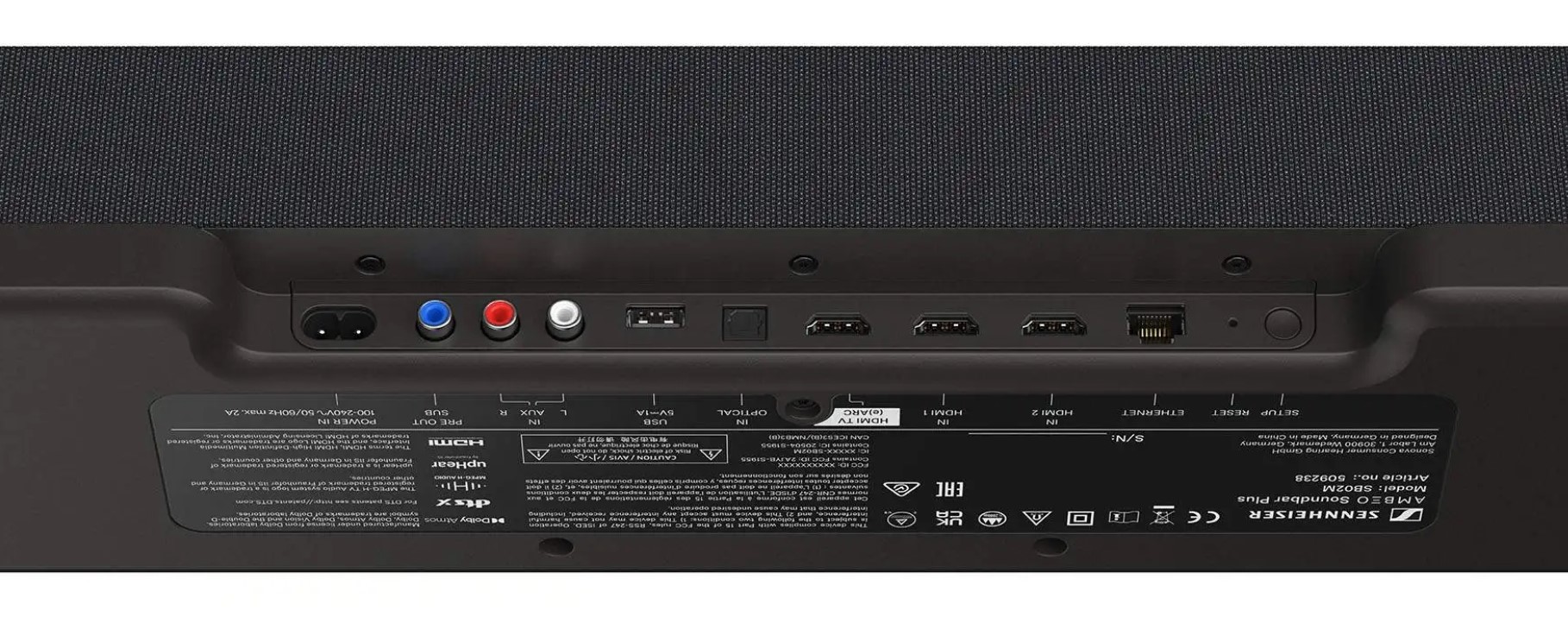Sennheiser Ambeo Soundbar Plus – convincing Dolby Atmos (soundbar review)

The Sennheiser Ambeo Soundbar Plus is an all-in-one soundbar providing 400W of virtual 7.1.4 sound. It is an excellent addition to any TV that can play Dolby Vision/Atmos content.
Upfront, no matter how good the Sennheiser Ambeo Soundbar Plus is, you must remember that it is an all-in-one soundbar relying on psychoacoustics to bounce 3D height and surround sound objects off and create a virtual Dolby Atmos (DA) ‘listening envelope’ – all from one soundbar.
To clarify 3D height comes from up-firing speakers (Left/Right) that bounce off the ceiling. The effect is diminished if this is more than 3 meters high or a raked ceiling. Surround sound comes from side-firing speakers (Left/Right), and the effect diminishes unless a nearby wall is on either side.

| Website | Product Page and Manual |
| Price | $2,499.95 but seen for $1999 – free delivery and 30-day return $1195.95 for the Sub (black) |
| From | Sennheiser online, Harvey Norman, Officeworks, Qantas Marketplace, Addicted to Audio, Amazon AU |
| Warranty | 2-year warranty (exceed) |
| Made in | Switzerland and Vietnam |
| Company | Sennheiser (Est 1945) is a privately held German audio company specialising in designing and producing a wide range of high-fidelity products, including microphones, headphones, telephone accessories, and aviation headsets for personal, professional, and business applications. Sonova Holding, a global medical hearing solutions provider based in Switzerland, now owns its consumer audio business. |
| More | Cybershack Sennheiser news and reviews |


In the box
- Soundbar
- Premium High-Speed 18Gbps 1m cable (too short)
- IR Remote and batteries
Remote and sound presets
The remote is well made, not backlit, and uses Infrared, so it needs to be within 6 metres and have a line of sight. It has preset buttons and one to activate Ambeo processing.
- Adaptive: Automatically adapts to the content being played.
- Music: Optimised for music.
- Movie: Optimised movies.
- News: Optimised for news/voice.
- Neutral: Reproduces the sound source unchanged.
- Sports: Optimised for the playback of sports broadcasts.
There is also Night Mode (no bass), Voice mode (1-4kHz and very good for hearing impaired) and Centre channel (forward-firing) volume.
You can edit each preset in the App. We won’t go into the App in detail. It is the same as the Sennheiser Amboe Mini.
Ambeo OS
In layperson’s terms, Sennheiser thinks this is the sound you want to hear. Audiophiles will always select Neutral or turn Ambeo processing off.
- Light spatial sound.
- Regular.
- Boost.
- Foundation – bass adjustment.
- Low-mid adjustment.
- Clarity and Brilliance – mid-high treble.
- Preset reset in case you Frenkensound it.
Speakers
It has nine speakers and amplifiers.
- Left/Centre/Right 2”full-range forward-firing (3.0.0)
- Left/Right 2” side-angle-firing (2.0.0)
- Left/Right 2” up-firing (0.0.2)
- Left/Right 4” up-firing woofer (0.2.0)
In Dolby Atmos parlance, this is 5.1.2. Sennheiser claims that the Ambeo OS can phase (move sound precisely between speakers) and virtualise 7.1.4 sound. Its self-calibration tries hard to faux position seven virtual speakers around your listening position. It may work under ideal psychoacoustic circumstances, but our tests found it to be more front-centric with some 3D height and limited surround.
Without a dedicated sub-woofer, there is no room-shaking bass (Jurassic Park fans beware).

Ports and inputs
- HDMI eARC 2.1 48Gbps – need to use a Premium High Speed 48Gbps cable (1m supplied)
- 2 x HDMI 2.0a 18Gbps
- RCA stereo in Left/Right
- Optical in (Toslink)
- USB-A 5V/1A/5W (can use flash drives or USB sound output from a laptop).
- Sub-woofer RCA out
- Ethernet 10/100
- Wi-Fi 6 AX 2.4/5GHz
- Bluetooth 5.0 BLE, Receive only, SBC and AAC codecs – recognises the last six devices.
- Spotify Connect client over the home network.
- Works with Chromecast, Apple AirPlay 2, and Tidal Connect.
While it has 2 x HDMI inputs, these are 2.0a 18Gbps and support compresses Dolby Vision and Atmos. You are better off plugging PS5/Xbox X into the TV and passing through sound to the soundbar. They have sufficient bandwidth for Fetch, Foxtel, Google Chromecast 4K and Amazon FireTV dongles.
Note that using an HDMI ARC port on your older TV will likely not get passthrough processing for Dolby Atmos/Dolby Digital Plus/DTS:X/DTS-HD/MPEG-H or Sony 360 Reality Audio.

Setup
You can use the soundbar without an App, but you will need the manual as it has a light bar instead of an English language readout. The bar is confusing. It can be white, light blue, blue, green, purple, and red with flash, sequence, ascending or descending swipe, and more. Our test panel was most critical of this trend – many companies now use it.
In addition, there is a Codec LED for Dolby Atmos, DTS:X, and MPEG-H.
Sennheiser recommends you sit at least 2m from the soundbar. We found that this 2-3m virtual DA envelope was reasonably critical to getting any virtual DA effect.
Mics
There are four far-field mics on the device. These are used for Alexa and room calibration. A mic mute button and LED turn these off.
Power
240V/2.5A/600W but in our tests it never exceeded 400W in full DA mode. It has sleep mode at <1.9W (.5W Wi-Fi off).
Upmix
It can upmix 2.0 to 7.1 surround to faux 7.1.4, which is handy for video but not so much for music content where 2.0 is best (music should not be messed with!).
EQ
Contrary to popular opinion, an EQ cannot increase the native sound signature of a speaker. It can appear to give more bass by recessing mid and treble.
It has a four-band graphic EQ for each preset capable of many more “Frankensound’ combinations.
Voice control
Because it has Wi-Fi/Ethernet, you can use it with Alexa (built-in) or OK Google (with a Google speaker). It can be part of the multi-room speaker setup.
How does it sound?
Our white noise generator eclipses any setting and tests the maximum frequency response – native sound signature.
Sennheiser claim 38Hz-20kHz. Our tests (replicated several times) found the bottom limit was around 45-50kHz. The optional sub has 28-80Hz and adds a room-shaking feeling.
Refer to the gold line below: It has no low-bass (20-50Hz). At 50Hz, it kicks in and builds steadily to 100Hz (mid-bass). From there, it is flat (good) from 100-200Hz (high-bass), then to 6kHz, where it dips to avoid harshness, and then flat to 20kHz. This is a neutral sound signature (nirvana), neither adding nor subtracting from the sound.
Volume
It reaches 85dB (loud) with little distortion.
Sound stage
The sound stage with 2.0 to 7.1 (not DA) is about 600mm on each side of the soundbar, so it should work with 65+” TVs). It has excellent Left/Right separation and phases sound coherently from Left to Right (and vice versa). There is no real height except that voices and sounds appear to come from the TV screen.
Dolby Atmos (Tested 1917 Blu-ray movie on Sony UBP-X700 DV/DA firmware): The sound stage is even more expansive (given it has left/right side-firing speakers) and higher (given it has Left/Right up-firing full range speakers.
1917 has lots of explosions and overhead sounds. These are well-placed with decent object tracking. The overhead ‘envelope’ is best at 2-3m from the soundbar, losing effect by about 3m
